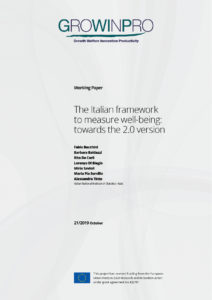The work of the Stiglitz’s Commission (2009) has renewed the attention on well-being as a multidimensional phenomenon and on beyond-GDP measures, fostering the gradual inclusion of well-being indicators in the policy agenda.
This debate calls for a new phase in the measurement of well-being. The exploitation of new data sources, hence new and more punctual indicators; a new metric apt to take into account interactions between the well-being dimensions; an explicit inclusion of well-being indicators in the policy cycle are part of a process leading to the 2.0 version of well-being.
The Italian experience on the measure of equitable and sustainable well-being (Bes) is a good example to illustrate this evolution. The current Bes framework are fully analyzed together with three emerging issues: the use of administrative data; the definition of composite indices as a useful synthesis for well-being; the implementation of well-being indicators in the policy cycle.

 The Italian framework to measure well-being: towards the 2.0 version
The Italian framework to measure well-being: towards the 2.0 version